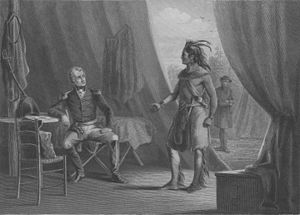Patriot War (Spanish East Florida) 1812-1814
| The Patriot War (Spanish East Florida) 1812-1814 | |||||||
|---|---|---|---|---|---|---|---|
| Part of War of 1812 | |||||||
 William Weatherford surrendering to Andrew Jackson | |||||||
| |||||||
| Belligerents | |||||||
|
United States Spain (Spanish East Florida Territory) Seminoles Black Seminoles |
Georgia Militia Tennessee Militia | ||||||
| Commanders and leaders | |||||||
|
Andrew Jackson John Coffee William McIntosh |
William Weatherford Menawa Peter McQueen | ||||||
| Strength | |||||||
| 7,000 | 4,000 | ||||||
| Casualties and losses | |||||||
|
~584 killed, unknown wounded |
~1,597 killed, unknown wounded | ||||||
The Patriot War was an illegal, clandestine and ill-advised U.S. military insurrection fought before and during the War of 1812 that was instigated by George Matthews (former governor of Georgia) who convinced President James Madison that Spanish East Florida could be easily annexed as its inhabitants were anxious to overthrow Spanish authority and join the United States.[1] Madison and U.S. Secretary of State James Monroe were eager for expansionism especially after the U.S. was successful in annexing part of Spanish West Florida in 1810. Additionally, Madison feared that Spain would form an alliance with Great Britain as tensions between the U.S. and Great Britain were escalating towards the War of 1812. Madison was also cautious about Spain allowing Great Britain to set up bases of operations in their West and East Florida territories for potential attacks on southern boundries of the U.S.[2] A secret act passed by the U.S. Congress on January 11, 1811[3] set the plans to acquire and occupy both Spanish West and East Florida. Matthews and Colonel John McKee were appointed as agent provocateurs in the covert scheme. Matthews gathered a militia force mainly from Georgia, which were called the 'Patriots', that consisted of many land hungry scoundrels and opportunists seeking economic gains from the invasion into East Florida. Realizing the 'Patriots' had the support of U.S. military forces Matthews led an attack on Fernandina and Amelia Island and took possession of them on March 17, 1812. This successful attack was accomplished with the assistance of U.S. Navy gunboats who fired on Fort Mose which scattered, disorganized and weakened the Spanish troops that were protecting the area. Matthews promptly turned these possessions over to the U.S. government. While Amelia Island was under U.S. occupation the 'Patriots' created a new republic called the Republic of East Florida that had a constitution, legislative council and court system.
Matthews proceeded to march his marauders toward the city of St. Augustine (the capital of East Florida) and surrounded it and its stronghold fortress Castillo de San Marcos. They had intentions to defeat the Spanish militia (including well-trained freed black troops), seize the area and dispose the official Spanish government in East Florida.[4][5]
Major newspaper denouncements, public outrage and domestic and international political pressure embarrassed the Madison administration regarding their ineptitude, mishandling and poor leadership of the Patriot War. On April 4, 1812, Madison rescinded Matthew's commission and denounced the annexation of Spanish East Florida. But, Madison continued secret support of the insurrection as he appointed Governor David Brydie Mitchell of Georgia to succeed Matthews.[6]
The Patriot War evolved into guerrilla warfare that resulted in a scorched-earth policy and alienated and terrorized Native Americans, American and Spanish citizens, free blacks and escaped African slaves (Maroons). On April 26, 1813, U.S. forces began to evacuate East Florida, but proceeded to burn and pillage homes and businesses of settlers they deemed to be loyal to the Spanish crown. With the refusal of the U.S. Congress to support or recognize the Patriot government, coupled with the Seminole's ambush and killing of General Buckner Harris (American Revolutionary War veteran and officer in the Georgia militia) on May 5, 1814, the Patriot movement dissolved. The Patriot War ended in a political and military debacle for the U.S. government as Spain was able to defend and maintain their possession of the East Florida territory.[6][1]
Prelude to War[edit]
Fernandina is Captured[edit]
Stronghold of St. Augustine[edit]
U.S. Forces Evacuate East Florida[edit]
Guerrilla Warfare[edit]
Collapse of the Patriots[edit]
References[edit]
- ↑ 1.0 1.1 Kruse, Paul. "Secret Agent in East Florida: General George Mathews and the Patriot War." The Journal of Southern History, Vol. 18, No. 2 (May, 1952), pp. 193-217.
- ↑ Pratt, Julius W. "Expansionists of 1812." The Mississippi Valley Historical Review, Vol. 12, No. 3 (Dec., 1925), pp. 431-432.
- ↑ Logan, John Arthur. "No transfer: an American security principle." New Haven, CT: Yale University Press, 1961.
- ↑ Stagg, J.C.A. “James Madison and George Mathews: The East Florida Revolution of 1812 Reconsidered.” Diplomatic History, Volume 30, Issue 1, 1 January 2006, pp. 23–55.
- ↑ Patrick, Rembert W. "Florida Fiasco: Rampant Rebels on the Georgia-Florida Border, 1810–1815.” Athens, GA: The University of Georgia Press, 1954.
- ↑ 6.0 6.1 Cusick, James G. "The Other War of 1812: The Patriot War and the American Invasion of Spanish East Florida." Athens, GA: The University of Georgia Press, 2003.
External links[edit]
- Patriots Revolt: Amelia Island in 1812.
- The Patriot Constitution of 1812.
- The Patriot War of 1812-1814 appeared to be the spontaneous action of Georgia militia.
- Fort Mose Historical Society.
- Fort Matanzas National Monument.
- Castillo de San Marcos National Monument.
- Seminoles of the Alachua area (Seminole Chief Payne) and their black allies - Paynes Prairie Preserve State Park.
- Fort St. Nicholas.
This article "Patriot War (Spanish East Florida) 1812-1814" is from Wikipedia. The list of its authors can be seen in its historical and/or the page Edithistory:Patriot War (Spanish East Florida) 1812-1814. Articles copied from Draft Namespace on Wikipedia could be seen on the Draft Namespace of Wikipedia and not main one.
